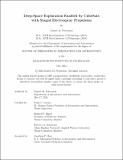Deep-Space Exploration Enabled by CubeSats with Staged Electrospray Propulsion
Author(s)
Pettersson, Gustav M.
DownloadThesis PDF (12.79Mb)
Advisor
Lozano, Paulo C.
Terms of use
Metadata
Show full item recordAbstract
From their beginnings as an educational experiment, CubeSats have grown to a popular technology development platform and a capable tool for scientific missions. Deep-space CubeSats have been limited to rideshare launches thus far, acting as companions to enhance large missions or using propulsion to reach science orbits near the destination of the primary mission (e.g. to Mars or around the Moon). More CubeSat companions are planned on future high-profile missions and the concept is likely to continue to gain popularity, but is inherently limited by the primary mission. This thesis looks towards the next step: dedicated scientific deep-space CubeSat mission applications and technology development. The asteroid belt contains unique scientific value as the small bodies in this region are remnants of solar system formation. Because there are over a million known bodies spread across dozens of types, however, it is infeasible to explore a representative sample with large missions. To solve this, swarm missions that explore the asteroids have been proposed, where a “mothership” is launched from Earth and transfers to a central location in the asteroid belt and releases a “swarm” of tens of smaller spacecraft to visit a sample of asteroids. So far, likely because of a combination of weak science motivation and poor technology readiness, no mission of this type has become reality. This thesis addresses the first part with two mission concepts that are strongly motivated by the decadal survey for planetary science and astrobiology: a swarm to visit the members of an asteroid family, and a swarm to visit a broad sample of the largest asteroids. The second part is addressed by leveraging the technologically mature CubeSat platform, which already solved many of the challenges of swarm missions, and making progress on some of the remaining limitations. Two factors that challenge deep-space operations are the high propulsion capabilities (delta-v) required to impart meaningful orbit change and the falloff of available solar power away from the Sun, e.g. by a factor of five to ten in the main asteroid belt. Practical high delta-v CubeSat propulsion comes exclusively from electric propulsion, where the mass and volume of the propulsion system are reduced at the expense of higher power requirements compared to e.g. chemical propulsion. Unfortunately, the power demanded by state-of-theart electric propulsion options make them infeasible for many deep-space missions. Electrospray propulsion systems overcome the power challenge thanks to their high efficiency, but are not mature enough to operate as long as necessary to deliver the requisite delta-v. This lifetime limitation can be overcome by dividing the propulsion system into a series of stages, creating a flexible system that scales to large delta-v and uses little power. In this 2thesis, the first complete CubeSat staged electric propulsion system is analysed, designed, implemented, and tested, to where it is ready for an in-space technology demonstration. The analysis shows that propulsion systems based on this new technology can enable deep-space CubeSats capable of several km/s of delta-v in the asteroid belt in the near future. With propulsion well on its way to be solved, the main remaining limitation is the reliance of deep-space missions on ground resources, i.e. the deep-space network (DSN), for communications and navigation. With the number of satellites envisioned, either ground resources need significant expansion, or the method by which the CubeSats are operated requires change. By using the mothership as a communication and navigation relay the ground resource issue is eliminated. Some of the proposed missions are likely to be feasible with modifications of technology already available and demonstrated today, but the most ambitious mission variants shown in this thesis will require significant work. After a flexible mothership has been developed for the first mission, a wide range of exciting science missions in the asteroid belt will be possible, and the rapid technology development in the CubeSat sector can be leveraged in a new paradigm of scientific exploration.
Date issued
2024-05Department
Massachusetts Institute of Technology. Department of Aeronautics and AstronauticsPublisher
Massachusetts Institute of Technology